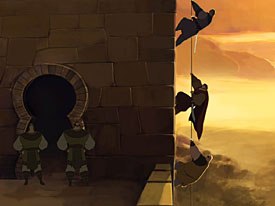David Sequera investigates the Spanish animated El Cid to find out if the seven million euro feature rivals films made in the U.S.
All cultures, all peoples, create their own myths and legends, which in the end, make the history of a country. El Cid, hero from the Reconquest of Spain in the Middle Ages, is one of the most legendary characters in Spanish history. His heroic deeds have gone beyond borders; they have filled thousands of pages in hundreds of books. They have also been shown in some animated series and several films (the most famous was the one starring Charlton Heston and Sophia Loren in 1961,which was directed by Anthony Mann and produced by Samuel Broston).
The legend says that the Castilian nobleman Rodrigo Díaz de Vivar, whom the Arabian people themselves nicknamed El Cid, because of his great fighting spirit, was even able to win a battle after his death. His loyal men tied him to the saddle of his inseparable horse Babieca, and put him at the head of the army. Such was the fear El Cid roused in his Muslim enemies that when they saw him, they ran away terrified. Reality or legend? We will never know for sure. But this may not be the last battle won by El Cid. On Dec. 19, 2003, in the heart of the Christmas campaign, the most ambitious Spanish animated theatrical film ever produced will be released in Spain: El Cid, The Legend. The competition for good box office is harder at this time of the year, but it is the time more people go to the theaters.



Writer/director José Pozo, producer and Filmax president Julio Fernández and Paco Rodríguez, co-exec producer (left to right) are aiming to reach a large Spanish audience with 250 prints opening week.
The people behind the movie are well aware of this, but they seem to have adopted their characters courage. So sure are they of the success of El Cid, The Legend that they have not spared any effort to release it during this Christmas. In fact the feature, directed by José Pozo, will be released in Spain with more than 250 copies and, according to Paco Rodríguez, the co-exec producer of the film, there probably will be 300 copies shown in the first weeks, a prohibitive amount for most Spanish fiction movies. The director himself recognizes this is the main objective for this film, which is 100% produced by Filmax Ent., as it challenges the hegemony of North American animation in the Spanish screens.

The Birth of a Legend
Doing an animated film about El Cid started in the late 90s when Pozo was already thinking about making an animated movie based on a historical character. One of the conditions he imposed upon himself was that the main character had to be universal, that is to say, that its story was well known and, overall, could be exportable worldwide.
The idea of El Cid, a Spanish hero from the Middle Ages who had already been immortalized in the screens, jumped out quickly with little research. Pozo went to Barcelona in the 2000 to join the animation department of the Filmax Group, the production and distribution company, which is chaired by Julio Fernandez. At Filmax Animation, the project gradually started to develop and take shape. However, they had to overcome some obstacles. Pozo got down to work at once and started to write the script for El Cid. It started as an extremely faithful report of the legend, and the producers did not like it, because it was a long and complicated script. It was not until the ninth version that the script was approved.
At first the script had more than 120 pages, and it was full of historical events, says Rodríguez. Some members of the team, including myself, were working for nearly four months before we got the final screenplay. Director/writer Pozo recognizes that the problems with the screenplay stemmed mainly from the historical point of view. The intention has been to spare the history of El Cid as much as possible, and I think that we have achieved it, because the soul of the character is in the movie, Pozo offers. But at the same time, we had to invent some situations and characters to be able to create a more pleasant plot for a very young audience. The idea was to get a screenplay that was not only respectful to the history, which also had all the ingredients of an entertaining animated feature.
A Risky Graphic Design in 2D and 3D
Only about 10% of El Cid, The Legend is in 3D, making it largely a traditional 2D film. Pozo explains that they made this decision due to the complexity of the characters. The 2D format allows us to show the characters feelings much better, according to Pozo. They went with 3D animation for more spectacular battle sequences or army movements. Both formats have also been mixed in the same frame in some scenes of the film.

Animo software was used in the traditional animation process for color, composition and camera, while SOFTIMAGE|XSI was used to bring the 3D toon characters to life. But this was not all, with the aim of giving some scenes more realism, the team created programs to improve the movements of the crowd and to avoid the many characters hitting one another by changing their speed and their direction. They also generated another program to make horses riding on the sand credible, so that one can see the particles of sand flying and the typical tracks this action produces.
One of the most outstanding challenges of the movie has been its innovative graphic design. The characters have a very risky graphic line, quite different from what is normally seen in productions about the Middle Ages. The movies creators staked on an ambitious graphic development, helped with an exquisite production design. Voluminous bodies and very small heads stand out, making it difficult for animation timing, storyboarding and the framing of the characters. Wed run into a very particular design, and we had to face that challenge, says Rodriguez. For example, when playing with the movie perspectives or with the close-up or medium shots of the characters, the movements of such voluminous arms involved a deal great difficulty, he explains.

A 7 Million Euros Budget
Perhaps, one of the most interesting characteristics of El Cid, The Legend is having achieved so much with so little. With a budget of nearly 7 million, more than double the money stipulated at the beginning, Pozo can be proud of his work because his feature can compete with dignity all over the world. But this has not been an easy task. A very skilled team, made up by more than 500 professional people (including 150 animators) has worked for Filmax on this project for more than three years. These people have been working in animation studios in 17 countries throughout the world (Spain, Greece. Canada, Korea, Hong Kong, the Philippines, England, Ireland, U.S., France, Denmark).
The cornerstone of this project has been the axis made up by the Filmax headquarters in Barcelona, the studio in Valencia, Toon Factory and Bren Entertainment. Toon Factory was in charge of the color, background designs, layouts, some part of the animation work and also of all the computer graphic process including especial effects made with Animo. The Bren team, settled in Santiago de Compostela, in the north of Spain, was in charge of all the animation in 3D.

One of Filmax best choices was to forget the idea of creating an animation studio centered in Spain. We discarded the idea of doing all the work in Spain and we went abroad, with the added difficulty of keeping the uniformity in the models and in the animation process. Our main objective was to avoid the lack of balance between frames or between some sequences and others made in different studios in different parts of the world, says Rodríguez. To maintain control, a lot of resources had to be put into practice in the pre-planning production stage. The materials sent to any animation studio in different parts of the world had to be precisely explained so that the studio and its animators could correctly interpret them.
The sine qua non condition to choose the right studios was that they had to submit animation tests. We did not want to work with studios that sometimes say they can cope with 10,000 or 15,000 frames a month, says Rodriguez. In fact, none of them got to make 10,000 frames, not even all of the Asian studios together. The maximum number of frames we gave to any one studio at the production stage was between 3,000 and 4,000, points out Rodríguez.
At the end of spring 2003, the whole feature was already animated, and the color was finished in August. We havent really had enough time for post-production because we wanted to release at Christmas, at all costs, admits Rodríguez. Even so, we have tried to take a lot care with some aspects of the film such as the soundtrack, composed by Oscar Araujo, or the especial effects.
This fight against the time has made it impossible for Filmex to create a suitable line of merchandising products, according to Rodriguez, which presently amounts to a book about the Middle Ages with a multimedia CD, and a videogame is coming soon. You cannot start making the merchandising pieces just nine or six months before the release, since licenses can take a while to process. We are aware of it and I think that we will try to plan our future projects better, says the co-exec producer of El Cid, The Legend.
Subventions and International Sales
Even though its budget seems small, (about 20 times less than a feature made in U.S.) funding a project like El Cid, The Legend was not an easy task. The production company has received a subvention from the Valencia government, and some regional television companies from Spain have helped. But the big Filmax strategy is to complete the financing of the movie with international presales. El Cid, The Legend has been already sold to all of the European Union, some European eastern countries, Latin America, Arabian countries, Indonesia, Malaysia, Thailand, India and South Korea. One of the short term objectives is to sell the film rights for the feature to be shown in U.S. theaters, which would be a milestone for a Spanish animation picture.
All the reasonable doubts generated by such a complex production will be solved this December 19. The minimum box office estimated by Filmax for the Spanish market is about 1.8 million. If we dont get half million admissions, Ill throw myself away, claims Rodriguez. We have to get that figure at least, I mean, 1,800,000 euros. If the film is not a success, it will be a great disappointment, because we have done our utmost, not only at the production stage, but also at the marketing one. I think that Filmax understands perfectly that the success in the box office depends on the promotion and they have worked very well in that sense, Rodríguez concludes.
The die is cast.
David Sequera Canora is editor in chief for the professional magazine CINEINFORME, covering important film events in Europe such as the Cannes film festival, San Sebastian film festival, Cinema Expo in Amsterdam and Spanish film Screenings in Lanzarote, among many.








